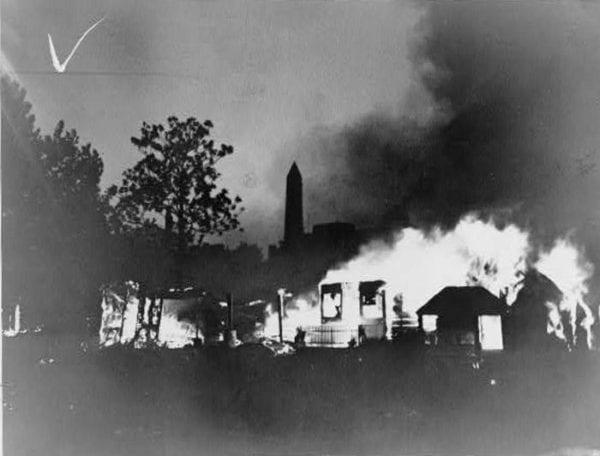In 1924, six years after the end of World War I, Congress voted to give a bonus to veterans – $1.25 for each day served overseas, $1.00 for each day served in the States. The catch was that payment would not be made until 1945.
The roaring twenties was a prosperous time, so the veterans found the delay acceptable. However, the onslaught of the Great Depression brought unemployment and starvation for many veterans, who then needed their money immediately.
In May 1932, thousands of veterans, led by former army sergeant Walter W. Waters, made their way to Washington D.C. and called themselves the “Bonus Expeditionary Force.” They were later dubbed the ‘Bonus Army.’
Estimates put the total number of protesters upwards of 20,000, including families.
They constructed their largest camp at Anacostia Flats across the river from the Capitol. Approximately 10,000 veterans, women and children lived in the shelters built from materials dragged out of a junk pile nearby. They laid out streets and maintained discipline and order. The Bonus Army conducted itself with decorum and spent their vigil unarmed.
‘We’ll stay here until the bonus bill is passed,’ Waters told anyone who would listen, ’till 1945, if necessary.’ He staged daily demonstrations before the Capitol and led peaceful marches past the White House. President Herbert Hoover refused to give him an audience.
On June 17, the Senate voted on the Wright Patman Bonus Bill, already passed by the House, to immediately give the vets their bonus money, however, it was defeated by a vote of 62 to 18. The crowd reacted with stunned silence.

Having no other place to go, the majority of the Bonus Army remained camped in the city, despite the fact that Congress adjourned for the summer shortly thereafter.
According to journalist and eyewitness Joseph C. Harsch, “This was not a revolutionary situation. This was a bunch of people in great distress wanting help.… These were simply veterans from World War I who were out of luck, out of money, and wanted to get their bonus — and they needed the money at that moment.”
On July 28, Attorney General Mitchell ordered the evacuation of the veterans from all government property. The Washington police were charged with this duty and they met with resistance. Shots were fired and two marchers killed.
President Hoover then ordered the Army, in defiance of The Posse Comitatus Act, to clear out the remaining veterans, and their families. Infantry and cavalry, supported by six tanks, were dispatched with Chief of Staff General Douglas MacArthur in command. Major Dwight D. Eisenhower served as his liaison with Washington police and Major George Patton led the cavalry.

By 4:45 P.M. the troops were massed on Pennsylvania Ave. below the Capitol. Thousands of Civil Service employees spilled out of work and lined the streets to watch. The veterans, assuming the military display was in their honor, cheered.
Suddenly Patton’s troopers turned and charged. This was no parade.
“Shame, Shame” the spectators cried. Soldiers with fixed bayonets followed, hurling tear gas into the crowd. Roughly 600 troops descended on the veterans destroying their makeshift camps as they went.
By nightfall the Bonus Army had retreated across the Anacostia River where Hoover ordered MacArthur to stop. Ignoring the command, the general led his infantry to the main camp. By early morning the camp was in flames. The day’s toll was three dead, including a baby, 54 injured and 135 arrests.
Disregarding orders-a common thread running through his career-MacArthur decided to finish the job by destroying the Bonus Army entirely,” historian Kenneth C. Davis writes. “After nightfall, the tanks and cavalry leveled the jumbled camps of tents and packing-crate shacks. It was put to the torch.”
Eisenhower later wrote, “the whole scene was pitiful. The veterans were ragged, ill-fed, and felt themselves badly abused. To suddenly see the whole encampment going up in flames just added to the pity.”

“Flames rose high over the desolate Anacostia flats at midnight tonight,” read the first sentence of the ‘New York Times’ account, “and a pitiful stream of refugee veterans of the World War walked out of their home of the past two months, going they knew not where.”
Many Americans were outraged. How could the army treat veterans of the Great War with such disrespect?
Hoover maintained that political agitators, anarchists, and communists dominated the mob. But facts contradict his claims. Nine out of ten Bonus Marchers were veterans, and 20% were disabled.
The Washington Evening Star wrote during the Bonus Army’s stay in D.C., “These men wrote a new chapter on patriotism of which their countrymen could be proud.”
by Shari Dovale
Sources and related articles:
- http://www.history.com/this-day-in-history/bonus-marchers-evicted-by-u-s-army
- http://www.historynet.com/the-bonus-army-war-in-washington.htm
- http://www.eyewitnesstohistory.com/bonusarmy.htm
- http://www.eyewitnesstohistory.com/snprelief4.htm
- http://www.pbs.org/wgbh/amex/macarthur/peopleevents/pandeAMEX89.html
- https://en.wikipedia.org/wiki/Bonus_Army
- http://www.rpadden.com/bonus/bonus_army_dagvin_r.htm
- http://www.ushistory.org/us/48c.asp
- http://www.learnnc.org/lp/editions/nchist-worldwar/5831
- http://www.gcsehistory.org.uk/modernworld/usa/impactofdepression.htm
- http://www.authentichistory.com/1930-1939/1-hoover/2-bonusarmy/
- http://zinnedproject.org/materials/the-bonus-army/
- Unintended Consequences by John Ross
- General Patton: A Soldier’s Life by Stanley Hirshson




